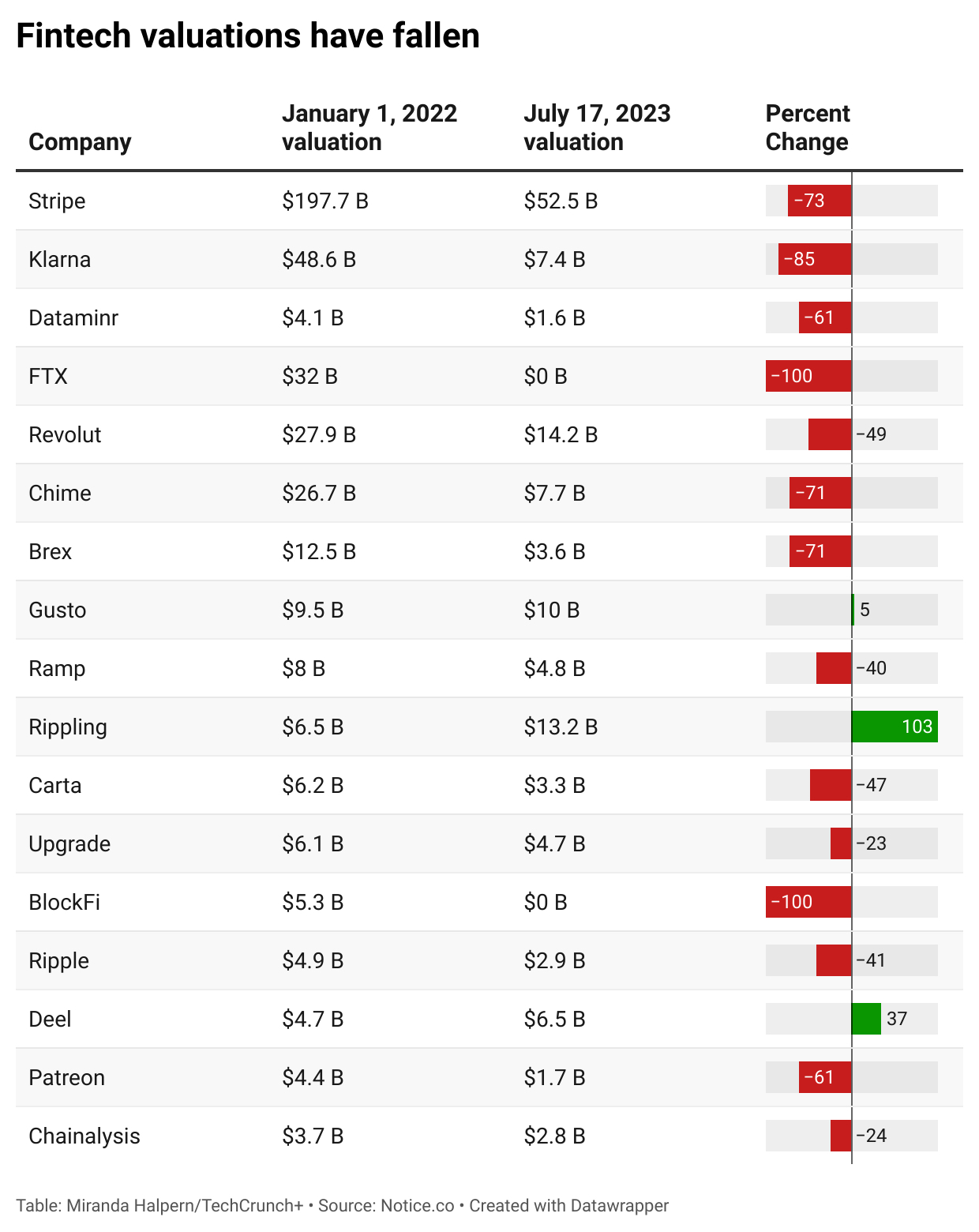With the market having changed dramatically since the heyday of 2021’s venture funding boom, fintech valuations have largely shifted accordingly.
With only a few exceptions, the once most valuable companies operating in the fintech space have seen their valuations drop significantly, based on secondary share activity as analyzed by Notice.co, a company that has built a pricing tool for the private markets.
One of the starkest examples of declines lies in payments giant Stripe, which saw its funding valuation hit $95 billion in March 2021. The company’s secondary market valuation peaked at nearly $200 billion in January 2022 (!), according to Notice’s data, which understandably caused frustration among employees who wondered why the company didn’t go public at that time. But as of the time of this writing, its secondary market valuation has plunged by 73% to $52.5 billion.
Only three fintech startups have actually seen their secondary valuations increase since January 2022: HR/payroll startups Rippling, Gusto and Deel. Those companies have seen their valuations climb by 103% (to $13.2 billion), 5% (to $10 billion) and 37% (to $6.5 billion), respectively, according to Notice.
Greg Martin (a co-founder and managing director at Rainmaker Securities, a secondaries trading platform) told TechCrunch+ that while some fintech unicorns are really solid businesses that were just a little overpriced, others haven’t come fully back down to earth yet. “Other people who are hanging on to their valuation are probably going to take longer to hit the bottom and find their way back up and have momentum,” Martin said.
Sparking momentum
The private markets are a great way to understand how companies are doing between funding rounds, said Notice founder and CEO Tyson Hendricksen.
“Financings are fewer and farther between these days, and the rounds that do get done often have structures that protect investors at the expense of employees and founders,” he told TechCrunch+. As a Global S&P report recently noted, funding to the sector was down almost 50% year over year, and the number of deals were down as well.

Image Credits: Miranda Halpern/TechCrunch
Martin said he thinks the secondary market is actually the most accurate place to find a company’s real valuation regardless of the overall market conditions. That’s because secondary deals get into a company’s real valuation and aren’t as influenced by optics sought out by both companies and investors, he said.
Still, buyers today are being picky, but both Martin and Hendricksen said they think that’s good. “Secondary demand is getting stronger in ‘blue chip’ names and companies with whispers of a coming IPO,” Hendricksen said. “Demand is weak for companies that fall outside this narrow band. New rounds, or the risk of new rounds, with heavy structure further limit buyer willingness to purchase earlier classes of shares that are likely to be negatively impacted when a down round or structured round happens.”
Martin has seen this as well. He said activity has started to pick up on certain companies, not because buyers were willing to pay more but rather because sellers had come down enough to spark momentum from investors. This momentum, he added, will be key for companies looking to raise enough interest to go public.
“In a way, it was smart to get to the bottom sooner because you will move up sooner, too,” Martin said. “Even though there were some pretty dramatic valuation [cuts], they actually set themselves up for the next round better.”
But he also believes there are “some good buying opportunities off the beaten path.”
Opportunities abound
Natalie Hwang, founding managing partner of Apeira Capital Advisors, said the compression of public company valuation multiples has caused investors to take a more conservative approach when valuing equity stakes in venture-stage startups, including fintech companies.
“Current challenges may have the impact of right-sizing the sector as well as valuations to give rise to a smaller but higher-caliber pool of companies that may become available to invest in at attractive prices,” she told TechCrunch+. “We believe that we may look back with the benefit of hindsight in 2022 and 2023 as optimal vintage years during which to deploy capital.”
PitchBook recently released its second-quarter Fintech & Payments Public Comp Sheet and Valuation Guide, and according to the data, share prices for recently public fintech companies have been rebounding faster than the wider market. They rose by 21.2% in the second quarter, compared with the Nasdaq’s 12.8% and S&P 500’s 8.3% return. How this will translate into the private markets remains to be seen.
However, it does look like the market is getting closer to pricing clarity. Martin said he is seeing more movement on the secondary market. Secondary-focused companies, including Forge Global and Caplight, have started to see this as well.
Hendricksen thinks that many fintechs will need to fundraise again soon. “We can expect down rounds that land somewhere near current secondary market pricing,” he said. “While there is plenty of pain ahead as official valuations reset, the companies that survive will be free of the unrealistic growth expectations built into their prior valuations. More investors and employees may finally be able to get the liquidity they need.”
